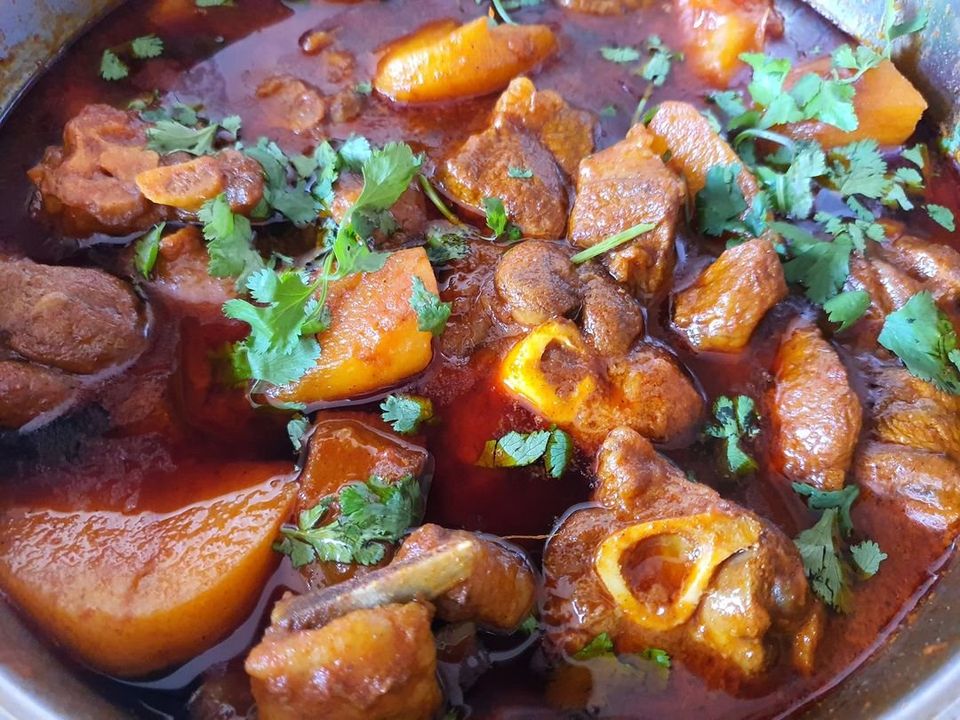
I have been working on this Durban Mutton Curry recipe for many years and there are still many years more to go – but I am getting somewhere.
Every time I cook curry, it is an adventure, it is therapy and it is fun.
Whilst the ingredients & quantities are pretty standard, I have a few techniques to get a rich thick gravy and super soft meat.
I mostly cook curry to make Bunny Chows, so I like to make a lot of gravy. My recipe may be a bit different, but it is because I have tweaked it to my preference.
Ingredients for every kg meat
- 1kg Mutton (Cut into pieces. Washed and patted dry with kitchen towel)
- 120 ml Sunflower Oil
- 2-3 Onions (Grated or very finely chopped)
- 2 Jam Tomatoes (Grated. Add more or less to your preference)
- 4-6 Tablespoons Masala / Curry Powder
- 1 Teaspoon Organic Cayenne Pepper (if you want to turn up the heat)
- 3 Star Anise
- 2 Cinnamon Sticks
- 1 Tablespoon Fennel Seeds (Ground with Pestle & Mortar)
- 3-4 Green or Red Chillies (or both)
- 1 Tablespoon of Homemade Garlic & Ginger Paste
- 1 Tablespoon of Homemade Dhania & Jeera Powder or Jeera seeds crushed with Pestle & Mortar (whatever you prefer)
- 1 Tablespoon Salt (add more or less to preference)
- 1/2 Teaspoons Turmeric (optional)
- Dhania Leaves to garnish
- 2-4 Large Potatoes (The amount is to your preference, but if you can get UTD Potatoes then these must be your first choice. We call then gravy soakers. UTD = Up to Date Potatoes)
Method
- Heat oil in heavy based pot
- Add cinnamon sticks, star anise, dhania & jeera powder, turmeric and allow to fry until fragrant.
- Add onions and saute until soft. (take care to not let your spices burn)
- Add your Curry Powder / Masala and allow to fry a bit. (again, take care not to let your spices burn. The mixture will become very thick now and it will burn easy)
- If you are adding extra Chilli powder or Cayenne Pepper, then add now.
- Add a dash of water if the ingredients are too thick – and stir. Allow the water to cook off whilst you adjust your heat so that the gravy boils but does not burn.
- Add your tomatoes and allow to saute until soft. This is where I put my most effort, in cooking the tomatoes down to make a smooth, thick, rich curry base. I use a wooden spatula or flat pointed wooden spoon to continuously scrape the bottom of the pot to bring up the flavours. The oil will come to the top when the gravy is reaching the right consistency.
- Add about half a cup of water. This is a debatable step, but I find that the water brings the gravy alive and allows me to cook it down to my required consistency rather than fighting a dry mixture and burning.
- Cover and simmer on a low-medium heat for at least 30 minutes.
- Remove the lid of the pot and allow the moisture to evaporate from the gravy. You are now preparing your gravy to saute your mutton (or any meat).
- Keep stirring and scraping the bottom of the pan with your utensil. The gravy will thicken up quite a bit at this stage and you do not want it to stick and burn. This gravy is the base of your curry and the more effort which you put in, the better results you will get.
- Add a few curry leaves into your gravy / base
- Remove your pot from the heat and stir in your mutton / meat in through the gravy, making sure that all pieces are well covered.
- Return the pot to the head and gently stir until the meat starts to fry in the gravy. You want the temperature of the gravy to go above at least 140c to achieve a Maillard Reaction. You want to use your utensil to scrape the meat and gravy from the bottom of the pot to the top, in the same manner you would turn a flower bed with a spade.
- When you are happy that your meat has fried enough (usually when the gravy gets really thick and wants to burn on the bottom of the pot) then add at least a cup of water. Your gravy must be thin enough to be able to gently simmer, with no chance of it burning on the bottom of the pot.
- Add a few curry leaves, turn down your heat, put the lid on the pot and simmer for at least 40 minutes. (40 mins for mutton, 20 mins for lamb) or until your meat is soft.
- When your meat is soft add your potatoes, some curry leaves and your salt. Add water until the potatoes are just covered.
- Partly cover the pot and allow to gently simmer until the potatoes are soft and the meat falls off the bone.
- Hint: If the water is not evaporating fast enough, then leave uncovered. You can always add a dash or 2 or water, if required.
- When your curry is ready, stir in a pinch or 2 of dhania leaves, a few curry leaves, another pinch or 2 of salt and let it stand for at least 15 minutes.
- Serve as a Bunny Chow, with Basmati Rice, with Roti or however makes your heart happy..
Check here for a Durban Lamb Curry Recipe (Step by Step with Photographs)
UPDATE: Don’t bother using all the different spices, just use our All-in-One Masala Range. Perfectly blended and balanced, just use 4 tablespoons per kg of meat / protein. Easy as that, best you will ever taste.
